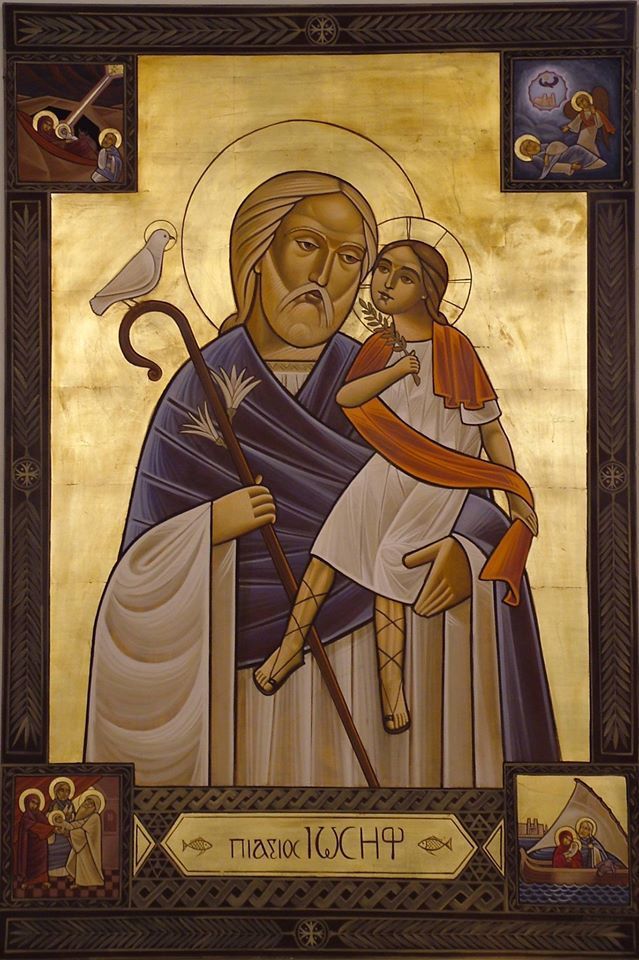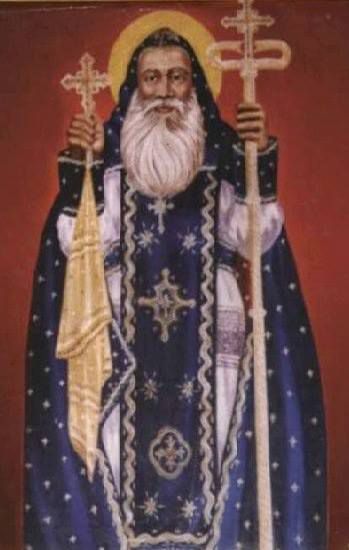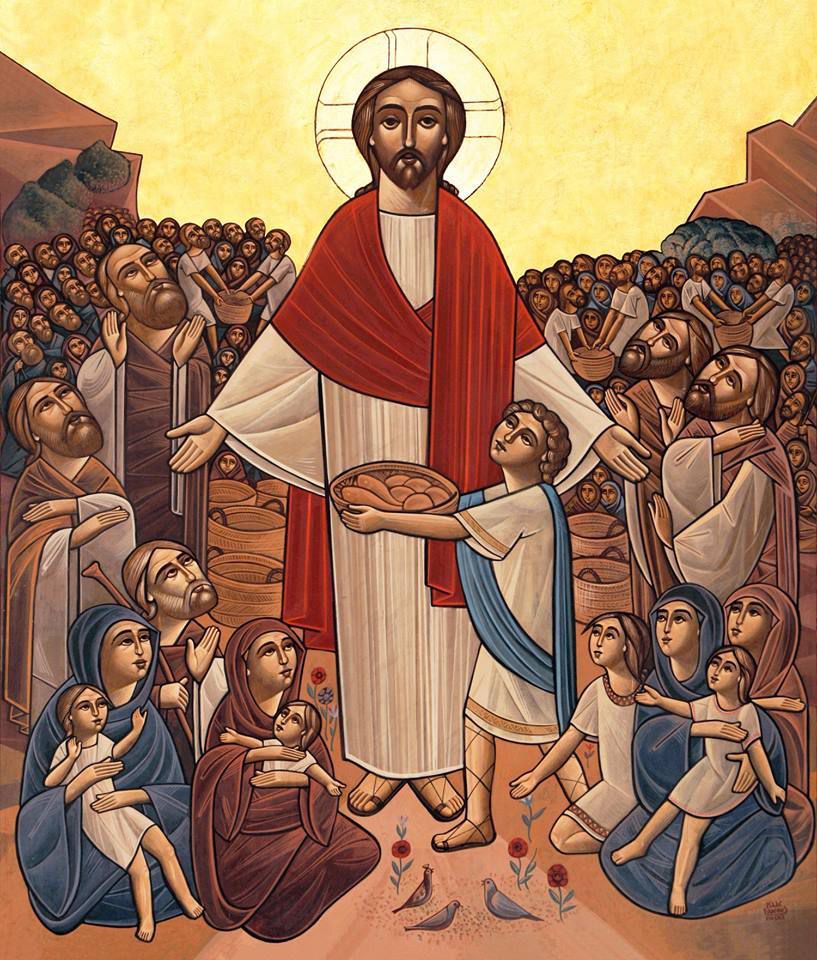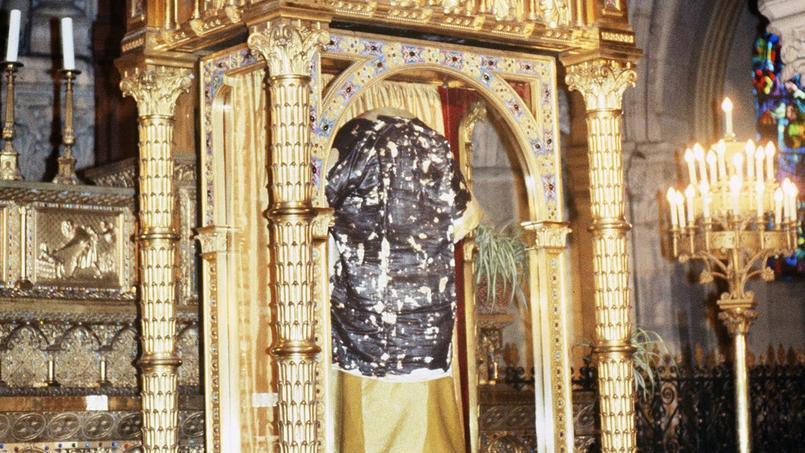The beginning of freedom from anger is silence of the lips when the heart is agitated; the middle is silence of the thoughts when there is a mere disturbance of the soul; and the end is an imperturbable calm under the breath of unclean winds.
Livre de Jérémie 7,1-7.
En ces jours-là, la parole du Seigneur me fut adressée :
Tiens-toi à la porte de la maison du Seigneur, et là prononce cette parole et dis : Ecoutez la parole du Seigneur, vous tous, hommes de Juda, qui entrez par ces portes pour adorer le Seigneur.
Ainsi parle le Seigneur des armées, le Dieu d'Israël : Réformez vos voies et vos œuvres, et je vous ferai habiter dans ce lieu.
Ne vous fiez pas aux paroles de mensonge de ceux qui disent : "C'est ici le temple du Seigneur, le temple du Seigneur, le temple du Seigneur !"
Mais si vous réformez vos voies et vos œuvres, si vous jugez justement entre un homme et son prochain ;
si vous n'opprimez pas l'étranger, l'orphelin et la veuve, si vous ne répandez pas en ce lieu le sang innocent, et si vous n'allez pas après d'autres dieux pour votre malheur,
alors je vous ferai habiter dans ce lieu ; au pays que j'ai donné à vos pères, d'âge en âge.
Évangile de Jésus Christ selon saint Luc 4,38-44.
En ce temps-là, en sortant de la synagogue, Jésus entra dans la maison de Simon-Pierre. Or, la belle-mère de Simon était prise d'une forte fièvre ; et l'on demanda à Jésus d'intervenir.
Venant auprès d'elle, il commanda avec force à la fièvre qui la quitta ; et s'étant levée aussitôt, elle se mit à les servir.
Lorsque le soleil fut couché, tous ceux qui avaient chez eux des malades souffrant de maladies diverses, les lui amenèrent ; et lui, imposant les mains à chacun d'eux, les guérissait.
Des démons aussi sortaient de beaucoup, criant et disant : " Tu es le Fils de Dieu ! " et, commandant avec force, il ne les laissait pas parler, parce qu'ils savaient qu'il était le Christ.
Quand il fit jour, il sortit et alla dans un lieu désert. Les foules se mirent à sa recherche et vinrent jusqu'à lui ; et elles voulaient le retenir, pour qu'il ne les quittât point,
mais il leur dit : " Il faut que j'annonce aussi aux autres villes la bonne nouvelle du royaume de Dieu, car j'ai été envoyé pour cela. "
Et il prêchait dans les synagogues de la Judée.
Par Baudouin de Ford
(?-v. 1190), abbé cistercien, puis évêque
Homélie 6, sur He 4,12 ; PL 204, 451-453 (trad. Orval ; cf bréviaire 30e ven)
« La Parole de Dieu est vivante et efficace, plus incisive qu'un glaive à deux tranchants » (He 4,12).
Toute la grandeur, la force et la sagesse de la Parole de Dieu, voilà ce que par ces mots l'apôtre montre à ceux qui cherchent le Christ, lui qui est la parole, la force et la sagesse de Dieu (1Co 1,24).
Cette Parole était au commencement auprès du Père, éternelle avec lui (Jn 1,1).
Elle a été révélée en son temps aux apôtres, annoncée par eux et reçue humblement par le peuple des croyants...
Elle est vivante cette Parole à qui le Père a donné d'avoir la vie en elle-même, comme lui la possède en lui-même (Jn 5,26).
C'est pourquoi elle est non seulement vivante, mais elle est la vie, comme il est écrit :
« Je suis la voie, la vérité, la vie » (Jn 14,6).
Et puisqu'elle est la vie, elle est vivante et vivifiante, car « comme le Père relève les morts et leur donne la vie, ainsi le Fils lui aussi donne la vie à qui il veut » (Jn 5,21).
Elle est vivifiante lorsqu'elle appelle Lazare hors du tombeau et lui dit :
« Viens dehors ! » (Jn 11,43)
Lorsque cette Parole est proclamée, la voix qui la prononce résonne à l'extérieur avec une force qui, perçue à l'intérieur, fait revivre les morts, et en éveillant la foi, suscite de vrais enfants à Abraham (Mt 3,9).
Oui, elle est vivante cette Parole, vivante dans le cœur du Père, dans la bouche de celui qui la proclame, dans le cœur de celui qui croit et qui aime.
« Si tu veux imiter à fond l'humilité de Jésus, tu devras participer à sa vie cachée, voilant, comme Lui, tout ce qui, en toi, peut attirer l'attention, les louanges d'autrui ; dérobant à leur vue tout ce qui peut te singulariser, te faire remarquer ; fuyant, pour autant qu'il dépende de toi, toute marque de distinction. « Aime à vivre inconnu et tenu pour rien », dit l'« Imitation de Jésus-Christ » (I, 2, 3) car de cette façon tu seras plus semblable à Jésus. « Lui, de condition divine, ... s'anéantit lui-même, prenant condition d'esclave et devenant semblable aux hommes » (Ph. II, 6 et 7). Jésus Lui-même nous a enseigné la pratique de la vie cachée, recommandant avec instance que le bien soit fait en secret, uniquement pour plaire à Dieu, sans aucune ostentation. Il t'enseigne ainsi à garder le secret de ta vie intérieure et de tes rapports avec Lui : « Pour toi, quand tu pries, retire-toi dans ta chambre, ferme sur toi la porte » ; - à celer aux autres tes mortifications et pénitences : « quand tu jeûnes, parfume ta tête et lave ton visage » ; - à ne pas mettre en évidence tes bonnes œuvres : « quand tu fais l'aumône, que ta main gauche ignore ce que fait ta main droite », car ceux qui font leurs bonnes œuvres devant les hommes pour être vus d'eux... « ils ont déjà leur récompense » et n'en recevront plus de leur Père céleste (cf. Mt VI, 1-17).
Je le confesse, Seigneur, et Vous le savez déjà, je suis bien loin de désirer, comme les Saints, l'oubli, l'indifférence des créatures, moi qui me sers souvent spontanément de petits artifices pour me faire remarquer, me mettre en évidence. Mais vous le savez, mon Jésus, je suis malade, et Vous savez aussi que je veux guérir en modelant ma vie sur la vôtre. C'est seulement pour Vous ressembler que je puis accepter et aimer l'effacement ; c'est uniquement pour mériter votre amour, vos regards, votre intimité, que je puis renoncer à la bienveillance, à l'estime des créatures... O Jésus, augmentez donc mon désir de vivre uniquement pour Vous, - et il me sera doux de vivre ignoré des hommes. »
P. Gabriel de Ste Marie-Madeleine, Intimité Divine Tome I (3e Semaine de Carême, 10 : La vie cachée, 1 et Colloque), Monastère des Carmélites Déchaussées, Librairie du Carmel, 1963.

|
|||||
|
« Les saints de Dieu sont proches des cœurs des croyants et ils sont prêts,
tels les amis les plus fidèles et les meilleurs,
à porter secours, à la minute, aux fidèles qui, dans leur piété les invoquent avec foi et amour. »
(Saint Jean de Kronstadt)

"The whole life of a man is but one single day for those who are working hard with longing." (St Gregory the Theologian)
Saint Gwénolé (ou Guénolé), qui êtes-vous ?

Fondateur de l'abbaye de Landévennec
(v. 460 - 532)
Né vers 460 à Ploufragran (Côtes-d'Armor, France), ou à Plouguin (Finistère), Gwénolé était le troisième fils de sainte Gwenn et de saint Fracan, frère de saint Jacut et de saint Guethenoc. Il fut confié à saint Budoc en 470 au monastère de l'île Lavret.
À 24 ans, saint Patrick lui apparaît, le dissuade de s'embarquer pour l'Irlande, et le prie de fonder un nouveau monastère. Il part avec onze compagnons et se fixe d'abord sur l'îlot de Tibidi au fond de la rade de Brest, puis sur la rive opposée de l'Aulne, à Lantowinnoc, Landévennec actuellement, qui devint un grand centre de la vie spirituelle de Bretagne.

Après sa mort, son culte se répand en Cornouaille bretonne et britannique. Dans l'abbaye de Landévennec, les moines ne manquent pas d'invoquer chaque soir « leur père saint Guénolé ». De très nombreuses paroisses de Bretagne sont placées sous son patronage en particulier Batz-sur-Mer.
===
Prière à St Gwénolé:
Breton fils de saint Fragan et de sainte Blanche,*
Frère de saint Guétenoc et de saint Jagut,*
Tu fus élevé craignant Dieu, par saint Budoc*
Créant le monastère de Landévénec,*
Tu menas tes moines aux frontières du Ciel.*
Saint Guénolé, prie le Seigneur de nous sauver
VIE DE SAINT GWENOLE:
Le père de saint Guénolé s’appelait Fragan. Né au Pays-de-Galles, il était de noble extraction puisqu'il était parent de Conan Mériadec, que beaucoup regardent comme ayant été le premier roi de Bretagne-Armorique. Au début du Ve siècle, il émigra en Armorique lorque les Romains, et avec eux un bon nombre de Bretons, quittèrent la Bretagne insulaire, et, abordant d'abord sur l'île de Bréhat, s’arrêta enfin sur les rives du Gouët aux environs de Saint-Brieuc en un lieu appelé aujourd’hui Ploufragan. Il était accompagné de ses deux jeunes fils, les futurs saint Jacut et saint Guéthenoc et de leur mère, sainte Gwenn, que l’on représente souvent avec trois mamelles, selon le nombre de ses fils. A peine arrivée, Gwenn donne naissance à son troisième fils, le futur abbé de Landévennec, en 418 ou 419. Fragan et Gwenn eurent encore une fille, plus tard, Creirvie.
Fragan et Gwenn avait fait voeu d'offrir saint Guénolé au Seigneur. Eduqué selon son rang, l’enfant manifesta très tôt des dispositions brillantes, et surtout une aptitude supérieure à la louange du Seigneur. Tout petit, il demanda à son père de le confier à quelque ancien, qui l’instruirait des choses de Dieu. Las, Fragan refusa, méprisant par-là son ancien voeu. Un jour où il visitait ses terres, il fut pris dans un orage épouvantable. Ses gens le virent dans une espèce d'extase pendant laquelle ils l'entendirent s'exprimer ainsi :
" Seigneur, Ils sont tous à vous, non seulement Guénolé, mais aussi Guethenoc et Jacut, mais aussi Creirvie, mais aussi leur père et leur mère !"
Quelques temps plus tard, Fragan emmena saint Guénolé au saint et vieux moine Budoc, sur l’île des Lauriers, entre l'embouchure de la rivière du Trieu et l'île de Bréhat, et appelée aujourd'hui l'île Verte. En chemin, les voyageurs furent pris par une brutale tempête, notre petit saint Guénolé s’empressa de la calmer par le signe de la croix.
Sous l’égide de saint Budoc, Guénolé apprend bien vite les lettres, et en quelques années devient " un éminent connaisseur accompli des Saintes Ecritures ". Sa sainteté se révèle dès la jeunesse, lorsque Guénolé guérit un camarade tombé en l’absence de l’abbé. Guénolé se distinguait par son humilité et son amour des pauvres qu’il secourt, guérit, console, nourrit, à l’insu de tous, leur enseignant l’Evangile. A un frère qui lui faisait des reproches sur ses enseignements aux pauvres, Guénolé répond tout joyeux :
" Béni sois-tu, frère très aimé, car tu as vraiment proféré contre moi le témoignage qu’il fallait. Alors que tous ont les yeux aveuglés, toi seul as les yeux assez ouverts pour me juger avec tant de vérité !"
La réputation de ses miracles se répandit bientôt et saint Budoc dut recommander à son disciple de ne pas, par sa modestie et son souçi compréhensible de se retirer des regards du monde, " éteindre la lampe que Dieu Lui-même a allumée, d’être condamné comme détenteur d’un unique denier, et de tenir pour superflus les dons de Dieu qu’Il a voulu que tu aies gratuitement ".
Parmi les miracles de Guénolé, on compte la guérison de l’oeil de sa sœur, arraché par une oie, le miracle des serpents chassés de la contrée, la résurrection d’un enfant tué par un cheval et celle de la mère d’un de ses moines et celle d'un ecuyer de son père, et bien d’autres encore.
Après quelques années auprès de saint Budoc, Guénolé fut pris du désir de s’en aller visiter saint Patrick en Hibernie (Irlande). Une nuit, il eut la vision du saint irlandais resplendissant, qui le dissuada de mettre son projet à exécution, mais le prévint qu’il devrait bientôt quitter l'île des Lauriers. Le lendemain, saint Guénolé s’ouvrit de cet événement à saint Budoc, qui, avertit lui même de la pertinence de la vision qu'avait eu saint Guénolé, lui recommanda d'obéir à saint Patrick, et, ayant choisit onze des plus saints religieux et ayant fait saint Guénolé leur supérieur, quoiqu'il n'eût que 21 ans, donna sa bénédiction à tous pour partir fonder un monastère.
Le petit groupe, guidé par la Providence, s’en alla vers la Cornouaille, et s’installa sur une île inhospitalière à l'embouchure de la rivière d'Aven, nommée Ti-Bidi (maison des prières). De l’île, se découvrait au loin le panorama de ce qui allait devenir plus tard Landévennec et les moines conçurent le désir de s’installer en ces lieux. Ils étaient cependant inaccessibles à pied, et c’est par la prière de saint Guénolé, qui tel Moïse ouvrit les eaux, que le petit groupe gagna ce qui allait être leur nouvelle retraire. Guénolé y fit jaillir une source, et la vie monastique s’organisa, les moines se multiplièrent.
La règle monastique, sur le modèle irlandais était sévère. Homme de prière, pétri de la lecture des psaumes, saint Guénolé fut aussi tourmenté par les démons, qui d’après les témoignages de ses voisins de cellule le visitèrent certaines nuits et reçevaient de lui semonces et belles réponses. Guénolé se distinguait par la sévérité de sa vie ascétique : il ne s’asseyait jamais à l’église, usait pour son vêtement uniquement du poil de chèvre, dormait à même le sol, une pierre sous la tête, prenait pour nourriture le strict nécessaire, mêlant de la cendre à son pain quotidien, ne mangeant que deux fois par semaines au cours du Grand Carême. Il guérissait les malades et on venait à lui de toute la contrée, recevoir réconfort et demander guérison. Les moines furent un jour témoin de la visite de Notre Seigneur Jésus-Christ, sous la forme d’un lépreux venu demander secours. Devant Guénolé, qui n’avait pas hésité à s’humilier pour guérir le malade, le pauvre devint resplendissant disant :
" Vous n’avez pas rougi de moi dans mes détresses, je ne rougirai pas de vous devant mon père."
On doit aussi à Guénolé la conversion de trois voleurs, venus cambrioler le monastère à l’heure de Prime. Arrêtés par Dieu dans leurs larcins, ils remirent leur vie entre les mains du saint moine, en demandant à être reçu dans la communauté.
Le roi Grallon, ayant eu connaissance de Guénolé, voulut le rencontrer. Ce roi n’était pas sans reproche et avait un caractère dur et violent. Il se mit à fréquenter les moines, et, après plusieurs entretiens particuliers avec saint Guénolé, fut touché et réforma heureusement son caractère impérieux mais dont le fond était bon et porté à la justice.
Saint Guénolé commanda au roi d’abandonner aux flots sa fille, coupable de nombreux vices et ayant corrompu la ville d'Ys. La légende comporte sans doute une part de vérité, celle de rappeler en particulier un cataclysme historique, qui sous la forme d’un gigantesque raz-de-marée, dévasta et ravagea les côtes de l’Armorique et probablement des îles sur lesquelles il ne faut pas exclure qu'y furent bâties. Rappelons à ce sujet, et pour étayer notre propos, que la baie du Mont-Saint-Michel fut inondée et envahie par les flots quelques siècles plus tard dans des conditions similaires et que les hauts-fonds en conservent encore les traces sous la forme d'anciens villages et monastères aujourd'hui immergés.
Dès lors, Grallon se retira à Landévennec, où il vécut jusqu’à sa mort. La vieille église romane conservait un tombeau que l’on disait celui du roi.
Parvenu à un âge vénérable, saint Guénolé reçut l’annonce de sa mort, et commanda à ses frères de se préparer. Selon la tradition codifiée au XIe siècle, il désigna pour lui succéder saint Gwenhaël. Ayant lui-même célébré la Liturgie et communié, chantant des psaumes et des cantiques debout devant l'autel et porté par deux de ses religieux, il rendit l’âme le mercredi de la première semaine de Carême, qui était le trois mars, et qui, selon le cyles Victorin, convient à l'an 504, où Pâque fut le 11 avril.

Les reliques de saint Guénolé reposèrent en son abbaye jusqu’aux invasions normandes qui dévastèrent l’abbaye dans les années 913. Les moines fuyèrent alors la Bretagne, et la toponymie permet de suivre leur périple : on trouve quelques paroisses dédiées à saint Guénolé sur les rives de la Manche.
Les moines furent invités à rester à Montreuil-sur-Mer, où ils fondent une abbaye portant le nom de saint Walloy, déformation flamande de Guénolé.
Une partie des reliques fut disséminée dans diverses paroisses de Bretagne et du Nord.
Une partie a été perdue à la Révolution, certaines sont revenues à Landevennec, à la réouverture de la nouvelle abbaye.
(Source: Père Duloisy sur FB)
"The Lord called His disciples blessed, for He said, 'Blessed are your eyes, for they see' (Lk.10:23). The apostles saw Christ in the flesh; they witnessed His sufferings and His miracles, and heard His words. We too desire to see, and to hear, and so be filled with gladness. They saw Him face to face, since He was physically present. Since He is no longer physically present, we hear His words read from books, and by hearing, our souls are sanctified and filled with blessings, and so we worship [God], honoring the books from which we hear His words. So also, through the painting of images, we are able to contemplate the likeness of His bodily form, His miracles, and His passion, and thus are sanctified, blessed and filled with joy. Reverently we honor and worship His bodily form, and by contemplating His bodily form, we form a notion, so far as possible for us, of the glory of His divinity. Since we are fashioned of both soul and body, and our souls are not naked spirits, but are covered, as it were with a fleshly veil, it is impossible for us to think without using physical images" - St. John of Damascus (On the Divine Images; SVS Press pg. 72)
Dès qu'il commença son enquête sur les événements qui venaient d'agiter la cité, il se fit lire les actes du Martyre de Saint Théodore et resta admiratif devant l'endurance et la bravoure du Saint. Il fit alors convoquer ses trois compagnons, qui étaient mentionnés dans les actes et avaient été incarcérés depuis dans la prison publique avec d'autres Chrétiens.
Puis, se tournant vers Cléonique et Basilisque, Asclépiodote les menaça de souffrir pires tortures encore s'ils refusaient de sacrifier. D'une seule voix les deux Saints répondirent :
Asclépiodote, voyant que l'affaire risquait de tourner à l'émeute, fit exécuter les nouveaux convertis et décida de convoquer tous les habitants de la cité avec les Chrétiens qui se trouvaient dans les prisons, pour offrir un sacrifice public au temple d'Artémis.
Le lendemain on les convoqua une nouvelle fois au tribunal. Eutrope et Cléonique furent condamnés à mort comme mages; et à l'instigation du diable, le père de toute division, le gouverneur ordonna de renvoyer Basilisque en prison, en vue de priver les Saints de leur belle unité1.
Toute la population païenne suivit les condamnés jusqu'au lieu de leur supplice avec une cruelle avidité.
1. Il est commémoré séparément le 22 mai.



† Holy Martyrs Eutropius, Cleonicus and Basiliscus (308)
March 3
They were fellow-soldiers and kinsmen of St Theodore the Tyro (Feb. 17). When St Theodore received his martyrdom, they were kept in prison because the governor of Amasia was unwilling to execute them. But a new and crueler governor, Asclepiodotus, took his place and ordered the three soldiers of Christ to be brought to him. At first, the governor used flattery and bribery to attempt to turn the three from Christ. He invitedEutropius to dine with him, but Eutropius refused, quoting the Psalm 'Blessed is the man that walketh not in the counsels of the ungodly.'
He then offered them a huge amount of silver, which they likewise refused, telling the governor that Judas lost his soul for silver. The governor then turned to torture, subjecting the three to extreme torments. At last, he condemned Eutropius and Cleonicus to crucifixion, for which they joyfully gave thanks that they had been found worthy to die the same death as Christ.
Basiliscus was held in prison awhile longer in hopes that the deaths of his companions would weaken his resolve; but when he remained steadfast in the Faith, he was beheaded, on May 22 (on which he is also commemorated) in 308.
Sources: Ancient Faith Radio
===

God is one and Christ is one, and His Church and faith are one, and the people joined together with the glue of concord into the unbroken unity of a body. It is not possible for the unity to be rent asunder, nor the one body to be divided by the tearing apart of the structure, nor to be torn into fragments with the violent rending apart of its vital organs. Whatever splits off from the parent tree is not able to live and breathe apart from it. It loses the essential nature of health. (St Cyprian of Carthage, On the Unity of the Church)
NEUVAINE A SAINT JOSEPH ?
L'occident chrétien se prépare à fêter Joseph, l'Homme juste, époux de la Vierge Marie, il veilla sur Jésus comme un père. Gardien de la Sainte Famille, il continue ,n'en doutons-pas, à intercéder et protéger l'Eglise du Christ. L'occident le fetera le 19 mars.
Tout ce qui n'est pas hétérodoxe dans les pratiques de piété peut être accueilli par les fidèles orthodoxes. L'Eglise d'occident propose une neuvaine à faire du 11 au 19 mars, mais elle peut être faite quand vous le désirez :
Dieu le Père a confié ce qu’il avait de plus précieux sur la terre, son fils Jésus, le Verbe Incarné et la Vierge Marie, à saint Joseph.
Alors, avec confiance*, n'hésitons pas à confier nos prières à son intercession.
*« Les saints de Dieu sont proches des cœurs des croyants et ils sont prêts — tels les amis les plus fidèles et les meilleurs à porter secours, à la minute, aux fidèles qui, dans leur piété les invoquent avec foi et amour. »
(Saint Jean de Kronstadt)
Prières quotidiennes pour la neuvaine :
♱Au nom du Père، et، du fils et du Saint-Esprit،
DIEU UNIQUE ET VRAI. Amîn.
V. Gloire au Père, au Fils et au Saint-Esprit †.
R. Et que sa miséricorde et sa grâce abondent en nous, pauvres et pécheurs, dans les deux siècles et jusqu’aux siècles des siècles. Amîn.
Kourie eleïson. Kourie eleïson. Kourie eleïson.
Seigneur ayez pitié de nous, Seigneur épargnez- nous et faites miséricorde, Seigneur exaucez-nous, ayez pitié de nous.
Gloire à Vous, Seigneur. Gloire à Vous, Seigneur. Gloire à Vous notre créateur, Gloire à Vous, notre Espérance pour toujours. Barekhmor.
Aboun d’bashmayo (Notre Père).
Les fidèles :
|
Qui êtes aux cieux, que votre nom soit sanctifié, que votre règne arrive, que votre volonté soit faite sur la terre comme au ciel. Donnez-nous aujourd’hui notre pain quotidien (substantiel), pardonnez-nous nos offenses, comme nous pardonnons à ceux qui nous ont offensés, et ne nous laissez pas succomber à la tentation, mais délivrez-nous du mal. Car à vous appartiennent le règne, la puissance et la gloire, dans les siècles des siècles. Amîn. |
Nethqadash shmokh, titheh malkouthokh, nehwe sebyonokh, aïkano d-bashmayo of bar'o. Hablan laĥmo d-sounqonan yawmono. Washbouqlan ĥawbaïn waĥtohaïn, aïkano dof ĥnan shbaqan lĥayobaïn. Ou-lo ta'lan l-nesyouno, elo fasolan men bisho, metoul dilokhi malkoutho Ou-ĥaïlo ou-teshbouĥto l'olam 'olmin. Amin. |
Je vous salue, Marie pleine de grâces ;
le Seigneur est avec vous.
Vous êtes bénie entre toutes les femmes et Jésus,
le fruit de vos entrailles,
est béni.
Sainte Marie, Mère de Dieu,
priez pour nous pauvres pécheurs,
maintenant et à l'heure de notre mort.
Amîn.
Je vous salue Joseph,
vous que la grâce divine a comblé
le Sauveur a reposé dans vos bras
et grandi sous vos yeux;
vous êtes béni entre tous les hommes
et Jésus, l'enfant divin de votre virginale Epouse
est béni.
Saint Joseph
donné pour père au fils de Dieu,
priez pour nous dans nos soucis
de famille, de santé, de travail,
jusqu'à nos derniers jours,
et daignez nous secourir
à l'heure de notre mort.
Amîn
Premier jour : A ton image, saint Joseph, puissions-nous vivre nos vies dans l’écoute et le respect de tous ceux et celles que nous rencontrons. Aide-nous à nous recevoir comme fils et fille du Père Céleste.
Deuxième jour :
Saint Joseph, tu peux être appelé "le saint de l’incarnation". Nous te demandons, d’être et de demeurer pour nous un modèle d’homme et de père juste et responsable dont le monde d’aujourd’hui a besoin pour sauver nos familles tellement menacées.
Troisième jour :
Que nos maisons puissent accueillir Marie et l’Enfant-Jésus. Ne craignons pas d’accueillir la Sainte Famille à notre table. Saint Joseph, protecteur de la famille, aide-nous à comprendre le sens de la paternité véritable afin que les pères de familles retrouvent leur identité profonde.
Quatrième jour :
Saint Joseph, devant l’Annonciation tu te mets à l’école de l’acceptation d’une solitude humaine totale pour vivre finalement avec Marie. Explique-nous combien il est important de ne pas rompre des liens affectifs et conjugaux dans l’épreuve. Aide-nous dans nos familles à triompher de toute solitude, de toute révolte, de tout divorce et de toute séparation.
Cinquième jour :
Saint Joseph, tu as été dans l’inquiétude de ne pas offrir à ta famille un lieu pour la nativité et tu as reçu dans l’obéissance et dans la confiance le lieu de l’oubli total : la crèche.
Au-delà de nos nuits et de nos pauvretés, apprends-nous à la grâce du St Esprit pour que meure en nous le "viel homme" pour laisser la place en notre coeur au Christ, l'Homme nouveau.
Sixième jour :
Saint Joseph, aide-nous à ne pas nous replier sur nous-mêmes dans l’épreuve et la maladie ; encourage-nous à nous ouvrir à la seule volonté du Père sur le chemin des béatitudes. Nous te confions spécialement nos malades.
Septième jour :
Saint Joseph, gardien de l’Agneau, protecteur de la Sainte Famille, tu es devenu, par la grâce du Père, le gardien de l’Eglise . Enseigne-nous à aimer notre Église, à lui être toujours fidèle et la faire grandir par notre assiduité aux Sacrements afin que, grandissant dans l'Amour et la cohérence du Témoignage,nous soyons missionnaires avec nos Evêques et nos prêtres.
Huitième jour :
Par notre union au Verbe Incarné, notre Divin Rédempteur et à Marie Compatissante, nous voulons aussi communier à la douceur et à l’esprit contemplatif du juste : Joseph.
Saint Joseph, apprend-nous à être amour et instrument de paix dans notre vie quotidienne pour tous ceux et celles qui attendent notre aide.
Neuvième jour :
Jésus, Marie, Joseph, priez pour nous et tous les membres de nos familles au moment de la mort. Nous vous confions spécialement tous ceux et celles qui nous sont chers, particulièrement nos chers défunts. Que le Seigneur les accueillent dans son paradis où tous ensemble reposent en Christ et jouissent de la béatitude éternelle.
« Seigneur Jésus Christ notre Dieu et Sauveur, pardonnez à Votre serviteur N… tous ses péchés, accueille-le dans Votre Paradis et sauvez-le au Dernier Jour! » Amîn
"God's children accept all things from His Hand as goodness, however troubling they appear to be" (Pope Shenouda )
A chant in Modus 1 "Quqoyo" and Modus 2 Trayono,
notated by Gabriel Assad.

Syrian Orthodox church music, Beth Gazo Dne'motho in
Suryoyo (approximately "Treasury of Chants") is
exclusively vocal and nowadays consists of about 700
chants. The chants constitute an integral part of the
liturgy. The church music is based on eight modes, in
analogy with both the Byzantine and the Gregorian modal
system. Each chant can be sung in every mode; the choice
of mode depends on when it is used during the church year.
(Source:
Commentaires de l'Ecriture par Saint Théophane le reclus.
"La victoire qui triomphe du monde, c'est notre foi"
(I Jean 5:4)
I Jean 4:20-5:21, Marc 15:1-15
Et la victoire qui triomphe du monde, c'est notre foi (I Jean 5:4), la foi chrétienne.
Vaincre le monde, qu'est-ce que cela signifie?
Non pas exterminer tous ceux qui aiment le monde, ou anéantir et détruire tout ce qui est aimé par le monde.
Cela signifie plutôt que tout en vivant parmi ceux qui aiment le monde et se meuvent parmi les usages appréciés du monde, nous vivons et sommes étrangers à tout et tous.
Dès que vous avez rejeté le monde et tout ce qui est du monde, vous avez par cette action-même vaincu le monde.
Mais qui vous apprend à rejeter le monde et qui vous donne la force pour cela?
Notre foi [orthodoxe] donne la force.
Elle révèle la puissance destructrice des illusions du monde, et inspire le désir de se libérer de leurs filets.
Puis, quand quelqu'un décide de briser ces liens, se repent et approche les Mystères de renouvellement (le baptême ou le repentir), la foi lui permet de sentir mystiquement la douceur d'une vie opposée au monde, douceur avec laquelle tous les plaisirs du monde ne peuvent en aucune façon être comparés.
En conséquence, un dégoût pour tout ce qui est du monde demeure dans le cœur, ce qui en fait vainc le monde.
Mais dans cette action mystique, à la suite de laquelle le dégoût pour le monde est né, le pouvoir de demeurer résolument dans ce dégoût et dans l'aliénation du monde est également accordé, et c'est une victoire décisive et durable.
(Version française Claude Lopez-Ginisty d'après St Theophan the Recluse Thoughts for each Day of the Year St Herman of Alaska, Platina, CA USA 2010 )

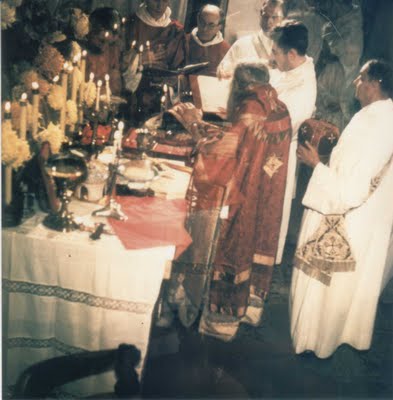 Saint John (Maximovitch) of Shanghai celebrating the Western Rite with Western Rite Orthodox in Paris.
Saint John (Maximovitch) of Shanghai celebrating the Western Rite with Western Rite Orthodox in Paris.
In recent years, some Orthodox jurisdictions in the United States and Great Britain have accepted whole parishes that converted from Anglicanism or Catholicism to Orthodoxy. These few parishes have the unique distinction of providing Orthodox services in the "Western Rite"—high Church services somewhat rewritten to adapt to the Orthodox cycle of services. A deacon of the Orthodox Church, Eastern Rite speaks in defense of this practice:
For over a century, the question of the Western Rite within the canonical Orthodox Church has been one of tremendous debate. Many Orthodox Christians of Western ancestry find within it a home, an answer to their deepest longings for a “rebaptism” of Western Christianity, and an opportunity to draw Western Christians back into the fold of the True Church. Others see the Western Rite as something foreign, misleading, and dangerous. These see the Western Rite as an innovation, and even (possibly) heretical.
What, though, are we Orthodox, to think of the Western Rite? Is it dangerous and wrong, or is it holy and good? What is the substance of the objections which well-intentioned Orthodox people have, clergy and laity alike? In what follows, I will look at several frequent arguments which are utilized in the opposition to the use of the Western Rite. I will examine them, and will answer them, not only from a Western Orthodox perspective, but also with honest evaluation from Eastern positions.
I will apologize here at the outset for the blunt, and possibly even polemical nature of much of what is said here. However, as our culture quickly descends into a politically correct world, where no one says what he or she actually means, bluntness is sometimes needed to make a firm point. Forgive me, a sinner, for the sake of Christ.
The Western Rite is Simply Reverse Uniatism
Perhaps the most frequent objection to the Western Rite movement is that it is simply “reverse Uniatism.” Of course, as many of us know, the Unia, or the Eastern Catholics, are those groups of people in historically Orthodox lands who, under political pressure, came under the Roman Pope, while retaining their Orthodox liturgical rites.
The claim that the Western Rite Churches are simply Orthodox Uniates is not only untrue, it shows something of a problematic ignorance of what the Unia actually is. First, Uniate Churches are former Orthodox bodies, which came under Rome for reasons which were mainly political, not religious in the least, and most of the time this union was forced by political leaders.
Further, the Uniate Churches (i.e.; the Ukrainian Greek Catholics, Melkites, Ruthenians, etc…) do not hold the same theological views as the Roman Church on many issues. Most notably, Uniates are not required to say the “filioque” in the Nicene Creed, and do not hold to Papal Supremacy in the same way that their Roman counterparts do. Rather, they hold to a view of the papacy that we Orthodox would, most likely, agree with, that does not coincide with the theology of their Roman brethren. Further, their theological views on the Sacraments are also completely different, such as the differences in theology and practice around Baptism, Chrismation/Confirmation, and first Communion.
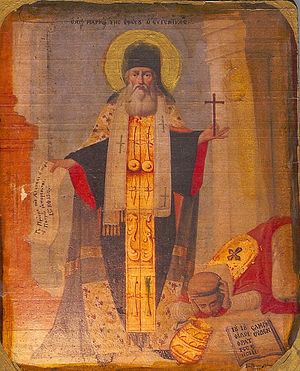 St. Mark of Ephesus, a pillar of Orthodoxy against false union with the Latins, who is, strangely enough, venerated by Eastern Rite Catholics
St. Mark of Ephesus, a pillar of Orthodoxy against false union with the Latins, who is, strangely enough, venerated by Eastern Rite Catholics
From viewing only these basic issues, it is fairly obvious that, even though they may be under the same papal umbrella, the Roman Church and the Eastern Catholics do not hold the same faith. The Western Rite, however, cannot fall under the indictment of being called “reverse” Uniates. In order for this to be true, the Western Rite groups would have to enter under the care of Orthodox Bishops, while maintaining not only their liturgical rites, but also their own heterodox theology, while claiming that only submission to an Orthodox Bishop is necessary for being part of the Church.
The Western Rites, however, are required to embrace, hold, and proclaim the same faith, the same theological positions, and the same sacramental theology, as the rest of the Orthodox world. In reality, the Western Rite is, simply put, Western Orthodoxy. This Western Orthodoxy is not opposed to Eastern Orthodoxy, but, rather, in harmony with it.
Whatever individual parishes might hold or practice that may be in error (which, of course should be dealt with by their respective bishops), the movement as a whole, and all the Western Rite Vicariates in the Canonical Church are required to hold the Orthodox Catholic Faith. Thus, the charge of “reverse Uniatism” falls flat, and is completely false.
The Western Rite is not part of our tradition/it’s not a living tradition
Another very frequently utilized argument against the Western Rite is that it is not a part of the living tradition of the Orthodox Church. The argument usually goes something like this: The Western Church left the historical Christian faith at the time of the Great Schism, and her liturgical rites, which have changed over time, have lost their Orthodox context. Thus, they have not been celebrated within the Orthodox context for a period of time deemed long enough to exclude their Orthodoxy. Therefore, so the argument goes, the Western Rite is not a “living” tradition.
However, this argument raises, by necessity, an essential question, which must be answered. This question is: what is a “living” tradition? For Orthodox opponents of the Western Rite, a liturgical rite must be continually celebrated and, relatively, unaltered for most (or all) of Christian history to be considered “living.”
However, this is not a Christian definition of anything being “alive.” What makes something alive is the presence of Christ, the working activity of the Holy Spirit. If something exists within the Church, and is blessed by the hierarchy, and celebrated by the faithful, in accordance with the True Faith, then it is alive.
Would any of us argue that the Liturgy of the Pre-Sanctified Gifts, or St. Basil’s Liturgy, are not part of the “living” tradition of the Church during the periods of the year when they are not in use? And further still, the Western Rite liturgies have a wider modern use than the Liturgy of St. James, but those who would discredit the Western Rite see no problem with the idea that this liturgy is “alive.”
What makes a liturgical form or rite “alive” is that it is celebrated, that it is used in the Church for the worship of God, and the feeding of His people with the sacraments of the Church. Whether or not something has had continuous use since the time of the Apostles to the present is not a measure of life, because we need only look at some of our own Orthodox parishes and see that though the correct “rite” and theology may be present in an exterior manner, while the parish itself is dead or dying because those rites have not become an interior reality. This is possible in the East or West. There is no distinction here. If the celebration of these liturgical rites brings about a true experience of God, this is the true mark of their validity.
We must remember that we worship the God Who is invested in giving life to the dead. Why would we say that He cannot and would not breathe new life into an ancient Liturgy again? Rather than making some historical or philosophical argument about “living tradition,” we need only to look with our eyes (both physical and spiritual), and see if something is alive.
Further, to say that the Western Liturgies are not “our” tradition (meaning, of course, Orthodox Tradition) is to say that the liturgical rites celebrated by the Western saints of the first thousand years of Christianity were invalid. The great champion of the Western Rite of the twentieth-century, St. John the Wonderworker, of Shanghai and San Francisco, has told us clearly:
Never, never, never let anyone tell you that, in order to be Orthodox, you must be Eastern. The west was fully Orthodox for a thousand years, and her venerable liturgy is far older than any of her heresies.
This great saint saw the Orthodoxy in these rites, and he saw past the coating of heretical doctrines that have become associated with them since the Schism. He proclaimed that, though the churches may have fallen into error, the liturgy is sound. Therefore, if the liturgy is sound and true, then it is Orthodox.
Are there “orthodox” Traditional Catholics, Anglicans, or Lutherans left?
One frequent question that is raised is the issue of Traditional Catholics, Anglicans, and Lutherans who are conservative in their theology, but still remaining in their respective confessions. The issue usually is phrased something like this; “I could understand the Western Rite if there was a large group of Irish Catholics in the 1950’s that wanted to become Orthodox. But nowadays, those that are still Roman Catholic, Anglican, or Lutheran don’t remember those rites. So they should just come into the Byzantine Rite if they want to become Orthodox.”
The first point that needs to be raised is in terms of Anglicans and Lutherans. Generally speaking, those that leave these confessions to become Orthodox are coming from very “High Church” backgrounds to begin with. We must remember, that while certainly having “low Church” groups within these confessions, Anglicans and Lutherans are the most liturgical of all Protestant groups, and generally take their liturgy very seriously.
The Anglicans, in particular, have an incredibly deep sense of liturgy that is far more ancient in practice and origin, and deeper in reverence, than the modern Roman Catholic Rite, and is, in fact, quite beautiful. So in terms of “remembering the rite,” Lutherans and Anglicans don’t really need to remember it, they live it every time they step into a church.
Some would also say that the conservatives in the Lutheran and Anglican Communions are all now either Roman Catholic or Orthodox, and would ask of any remaining in these groups, “why would you come to Orthodoxy now, and not ten or twenty years ago.” The answer to this is clear: faithfulness. Many Anglicans, Lutherans, or even Presbyterians or Methodists, having been raised in these confessions, remain faithful to their churches, even though these churches are no longer faithful to them.
When these people decide to leave, regardless of the timing, to come to Orthodoxy, it isn’t for us to ask “why now?” It is for us to say, “thank God.” Further, if these people were that faithful to confessions which were running away from their historical faith, how faithful, then, will they be to Holy Orthodoxy when they find it! These are the people that we want in our parishes! These faithful give up so much to leave all they know, and it is possible for the Orthodox to bring them home, and embrace them, while giving them their liturgical forms that they know.
While it must certainly be conceded that the modern Roman Catholic liturgy is a far cry from the beauty and splendor of their former Mass (the liturgy normally used in Western Rite Orthodox parishes), we must also note the tremendous growth in Traditional Catholic parishes across the U.S. especially. Indeed, in the last 20 years, the parishes in the American Roman Catholic Church that have seen the most consistent growth have been those that celebrate the Latin Tridentine Mass daily. This growth has not been older people coming for nostalgia, as one might expect. Rather, these parishes are filled with twenty and thirty-somethings, who are longing for their roots.
What makes the Western Rite so necessary are exactly these facts. There are many High Church Protestants and Traditional Catholics who are searching for their Orthodox Christian heritage, and their own confessions are leaving them behind. In the case of the Traditional Catholics, in many cases they are actually treated like second class, with the new Charismatic-driven Novus Ordo parishes receiving favor.
It is precisely these people, these traditional conservative members of these liturgical bodies, that we must show the light of Orthodoxy to. Indeed, we can offer them something incredible: their deepest longing for participation in the form worship that their Western ancestors used, within the context of the True Faith of Jesus Christ. This is a tremendous gift, and we would be foolish not to use it, because it could, theoretically, change the world, and, for many Christians, heal the Schism, one Baptism at a time.
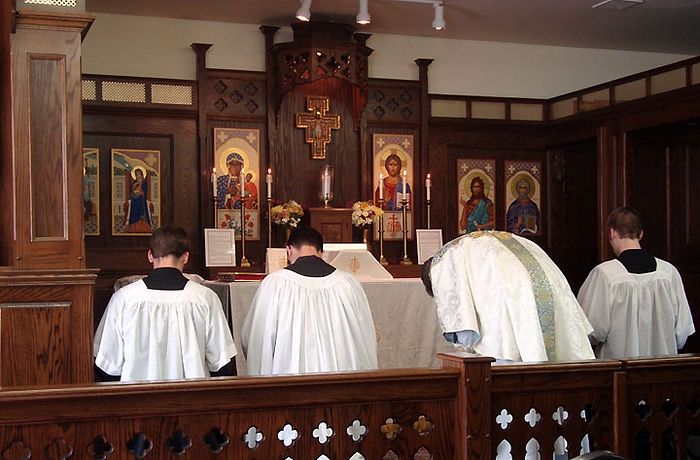 Holy Incarnation Western Rite Orthodox Church in Detroit
Holy Incarnation Western Rite Orthodox Church in Detroit
The Western Rite Liturgies are too Patri-centric
A very common objection that is used by Western Rite detractors is the idea that the Western Rite Mass is too “Patri-centric.” To put this another way, it is said that the prayers of the Western Liturgies are almost entirely directed at the Father, at the expense and negation of the Son. While this may or may not be true, the idea behind it is an interesting one.
It is often said by Eastern Rite objectors, “we pray ‘to Christ our God,’ they [the Western Rite] pray, ‘through Christ our Lord.’” In saying this, they are making the claim that Western Rite prayers are somehow deficient, and that God will not answer them, or some other such nonsense.
What we often forget in this line of argument is that we Byzantine Rite Christians do not pray exclusively to Christ in our Liturgies either, and there are even Patri-centric prayers in the Liturgy of St. John Chrysostom. The most obvious example is actually in the most solemn moment of our Liturgy: the Anaphora.
As we progress through the Liturgy, and approach the Mystery of mysteries, the prayer that is utilized is not a Christo-centric one, but rather, Patri-centric;
It is meet and right to sing of Thee, to bless Thee, to praise Thee, to give thanks to Thee and to worship Thee in every place of Thy dominion. For Thou art God ineffable, inconceivable, invisible, incomprehensible, ever-existing and eternally the same, Thouand Thine only-begotten Son and Thy Holy Spirit. Thou it was who brought us from non-existence into being, and when we had fallen away, didst raise us up again, and didst not cease to do all things until Thou hadst brought us up to heaven and hadst endowed us with ‘Thy Kingdom which is to come. For all these things we give thanks to Thee, and to Thine only-begotten Son and to Thy Holy Spirit; for all things of which we know and of which we know not, whether manifest or unseen; and we thank Thee for this liturgy which Thou hast found worthy to accept at our hands, though there stand by Thee thousands of archangels and hosts of angels, the Cherubim and the Seraphim, six-winged, many eyed, who soar aloft, borne on their pinions, singing the triumphant hymn, shouting, proclaiming and saying: Holy! Holy! Holy! Lord of Sabaoth! Heaven and earth are full of Thy glory! Hosanna in the highest! Blessed is he that comes in the name of the Lord! Hosanna in the highest!
Further, as our Liturgy is beginning, the very first prayer of the priest before the Altar is not a prayer to Christ, but a prayer to the Holy Spirit, the “O, Heavenly King.”
Now, one might bring forth an objection here saying, “we concede that some prayers in the Eastern Liturgy are not Christo-centric, but in the Western Church, all the prayers are Patri-centric.” Even this, though, isn’t true. While the great majority of Western Rite prayers are, indeed, directed to the Father, there are many exceptions.
First, one of the first moments of the Mass in the Western Rite is the “Kyrie,” in which the Priest and people antiphonally chant together, “Lord, have mercy. Christ, have mercy. Lord, have mercy.” Indeed, further, in the prayers just before Communion, the Western Liturgy gives us three beautiful prayers to Christ, the first of which says:
O Lord, Jesus Christ, Who didst say to Thine Apostles: Peace I leave you, My peace I give to you: look not upon my sins, but upon the faith of Thy Church; and deign to give Her that peace and unity which is agreeable to Thy will: One God, Who livest and reignest unto ages of ages. Amen.
Finally, it is simply a fact that, in the Western Church, the formula for prayer has alwaysbeen Patri-centric. It is curious that this was not a problem for the Eastern Christians when they were in communion with Rome before the Schism, but that some Orthodox Christians would use this as an objection to the Western Rite now.
Modern Orthodox Theologians Oppose the Western Rite
A further argument used against the Western Rite is that modern Orthodox “theologians” and scholars argue against its use. Among these are names such as Fr. Alexander Schmemann, Metropolitan Kallistos [Ware], and others. These scholars will make varied claims to historicity, Roman Catholic innovations, post-Schism devotions, and many other objections from an academic position.
This argument, though, can be easily deflected, however, in answering the following question; do academics determine Orthodoxy, or do the saints? The answer, of course, is the saints, or more specifically, the living activity of the Holy Spirit working within the saints of God in His Church, in accordance with Sacred Tradition.
We can plainly see that no matter how many “academics” may argue against the use of the Western Rite, they must stand up against the saints who supported it, including St. John Maximovitch, St. Tikhon of Moscow, St. Nicholas of Japan, and St. Raphael of Brooklyn, among others. There are also many other Orthodox academics, scholars, and leaders in the Church that support the Western Rite, men such as Vladimir Lossky, Patriarch Sergius I of Moscow,[1] Metropolitan Anthony (Bloom), Metropolitan Philip (Saliba), and Bishop Basil (Essey) of Wichita.
Will we, embrace the same scholastic mindset that we criticize in the Western Churches, and allow our faith and practice to be determined by academics? Or will we follow the testimony and lived experience of the saints? The answer is clear; if the saints of God and various Orthodox Synods have accepted something, there ends the matter. There is no more room for discussion on the acceptance of the Western Rite as something Orthodox. It has been proclaimed so, and has been accepted, and must be given every chance to grow and succeed.
The Western Rite incorporates non-Orthodox elements into the life of the Church
Another frequent argument is that the Western Rite brings into Orthodoxy elements of Church life that are not Orthodox in their origin. This can range from liturgical practices, paraliturgical devotions, and even vestments or clergy attire. This accusation is very often flung at Western Rite Orthodox by, especially, more “hardcore” or traditionalist Orthodox Christians. They argue that the introduction of certain Western elements into Orthodoxy pollutes the purity of Orthodoxy, and should be avoided by the suppression of the Western Rite.
One can only comment that these detractors are several centuries too late to make this argument. There are, indeed, many elements that exist within Orthodoxy that are not only of non-Orthodox, but even non-Christian origin. Aside from our theological language, with terms like hypostasis, which come from pagan Greek philosophy and are decidedly non-Christian, the average Orthodox parish, in America and elsewhere, has countless Western elements, whether they are aware of them or not.
Whenever we walk into a church and hear four-part music, see pictorial stained glass windows, meet a priest in a clergy collar or vestments that are in a particular “seasonal” color, these are western influences. These elements are now commonplace in our Orthodox Churches, and we don’t even consider that they are of Roman Catholic origin. We take for granted that they are Orthodox, and that they are a part of the worship of the Church.
Further, to answer those who are of a more “traditionalist” bent, we should point out that there are elements that are considered “traditionally” Orthodox that are not even Christian in origin. Some of these elements are very interesting in this regard, because some argue that they are the very markers which determine how an Orthodox priest should look, in terms of appearance.
Take for example, the riassa, and the wearing of long hair and unkempt beards, especially by non-monastic clergy. These are often considered the foundation of how an Orthodox clergyman should appear in public. There is a huge problem with this, however, as they are not Christian, but Islamic in origin. These were the markers of government officials during the Muslim Ottoman Turkish Empire, a period of time in which we, as Orthodox Christians, were subjugated under Islamic rule.
The same is true of the kamalavkion, or klobuk, as it was a Turkish judicial hat, as well as thesakkos and mitre, worn by bishops in the Liturgy, which were clothes worn by the Byzantine Emperors, and not historically by bishops until the Ottoman conquest. These items, worn today by all Orthodox clergy everywhere, bishops and priests, are not even Christian in origin, and, in terms of the riassa, long hair, and the kamalavkion, are even signs of Muslim domination over the Church, and yet we continue to wear them, and call them signs of the Orthodox priesthood, because they have been blessed by their use in the Church.
The traditional attire of an Orthodox priest is a simple cassock, black for monastics, and in various colors for married clergy, a beard, which is neatly trimmed if he lives in a city or town, and short hair, which is the Byzantine clerical tonsure. This is our true Orthodox heritage, but we ignore it in favor of Islamic norms. It is a strange curiosity that those who would argue against the introduction of Western Rite elements in the Church are the same people who embrace Western Christian, and even Islamic elements to their Liturgy and Church life.
 Native Alaskan Orthodox "spirit houses"
Native Alaskan Orthodox "spirit houses"
Finally, the Julian calendar, which is a sticking point of discussion to so many in the Orthodox Church, is not of Christian origin, but of pagan beginnings. Will we continue argue along these lines, splitting hairs, and making nonsensical arguments? Or, will we be truthful with ourselves, and look at the origins of what we do, and simply acknowledge the truth, that we have taken what is good in the world around us, and baptized it, to the glory of Almighty God.
Only the Byzantine Rite is acceptable for use in the Orthodox Church
An absolutely ludicrous and absurd claim, made by detractors of the Orthodox Western Rite, is that only the St. John Chrysostom, St. Basil, St. James, and Pre-Sanctified Liturgies are acceptable for use in the Orthodox Church. This idea is a complete innovation, and one cannot even be claim to see its origin in the Great Schism, but rather long after.
In actuality, the Orthodox Church had its own local liturgical rites in various geographical regions throughout the East. These included a distinctive Antiochian Rite, and Alexandrian Rite which were ultimately suppressed in favor of the Constantinopolitan Rite. This plurality of rites existed long after the Schism with Rome, and elements of these historically Orthodox rites can be seen in various liturgical variations throughout the Church.
There is no argument for the Byzantine liturgical primacy other than a pride, and historical ignorance, either innocent or deliberate. What is essentially being said by this argument is that God Himself only honors that Liturgy that is celebrated by the Byzantine Church in the modern era. This is an argument that negates not only the liturgical validity of everyWestern saint that the Orthodox commemorate, but also the saints of ancient Antioch, Syria, Alexandria, and others.
Is this what we really believe? Of course it isn’t. Every Orthodox Christian acknowledges the Orthodoxy of St. Gregory the Great, St. Benedict of Nursia, St. Cyril of Alexandria, St. Moses the Ethiopian, and all the other non-Byzantine saints. Why on earth, then, do we venerate their sainthood, but dismiss the Liturgies that formed them into saints?
Another factor here is a denial that the liturgical expression of the Byzantine Rite has changed, believing that it has been static since its beginning. This is, of course, ridiculous. Liturgical formation and evolution over time is simply a documented fact. Let us note an extremely early example; the difference between epicleses in the Liturgy of St. John Chrysostom and that of the Didache, or that used by the most ancient Church. They are very different, and are examples of liturgical development within the Orthodox Church. We could also point to doxologies and liturgical prayers in the Holy Scriptures, in the letters of St. Paul and elsewhere, that were used in the early Church and are no longer in use by the Orthodox Church. There is nothing wrong with this. Rather, it shows the maturing of the Church.
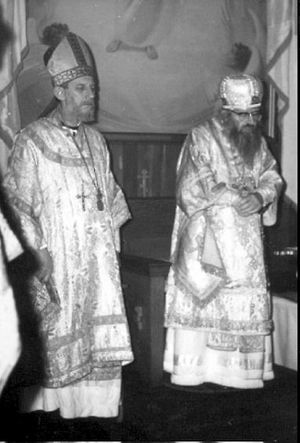 Bishop Jean-Nectaire (Kovalevsky) of Saint-Denis and St. John Maximovitch in 1964
Bishop Jean-Nectaire (Kovalevsky) of Saint-Denis and St. John Maximovitch in 1964
Let us call a spade a spade, and simply answer this criticism for what it is: ridiculous. This kind of argument, one that dwells on a static exterior, is what led to the Old Believer schism in the Russian Church, and there is not a single one of us that does not lament what a horrible tragedy that was. We must remember our brothers and sisters in Christ, honor their cultural differences in which truth can be found, as Orthodoxy has historically been wont to do. In doing this, let us see true Orthodox diversity as a blessing from God, as a mark of His Creative energies working through men in different places and in different times.
The Western Rite is Divisive
There are those that argue that the existence of the Western Rite within Orthodoxy is, by its nature, divisive. They argue that the liturgical variation brought about by the Western Orthodoxy causes an undue separation between the Western Rite Orthodox and their Eastern Rite brethren, driving a wedge in Orthodox Unity.
This argument could conceivably have some traction, because it has been manifestly true. However, the divisive attitudes that have emerged have not been a result of the Western Rite itself, nor have they usually been manifested in Western Orthodox Christians themselves. Rather, these attitudes are generally the result of a lack of any attempt to truly understand the Western Rite at all.
Western Orthodox Christians are our brothers and sisters in the Orthodox faith, not our enemies or competitors. What we see in this line of argument is, indeed, nothing less than the rampant phyletism that exists within the Orthodox world. This divisive attitude does not exist only between Eastern Rite and Western Rite Orthodox, but between Greek and Russian, cradle and convert, and the many “warring” jurisdictions in the diaspora which shamefully allow a non-canonical Church structure to continue because of pride and power.
Let us, again, be honest with ourselves. If the Western Rite is divisive, it is so because we have not yet obtained a heart that is formed in Christian love and charity. Differences in liturgical ceremony do not cause this kind of division of themselves. What does cause divisiveness is pride, and believing that what we are doing is the only “right” way. In being truly honest with ourselves, we must admit that the notion that there is liturgical uniformity, even within a single national Church or jurisdiction, and even from parish to parish in a single diocese, is complete fiction. Saying otherwise is simply not honest.
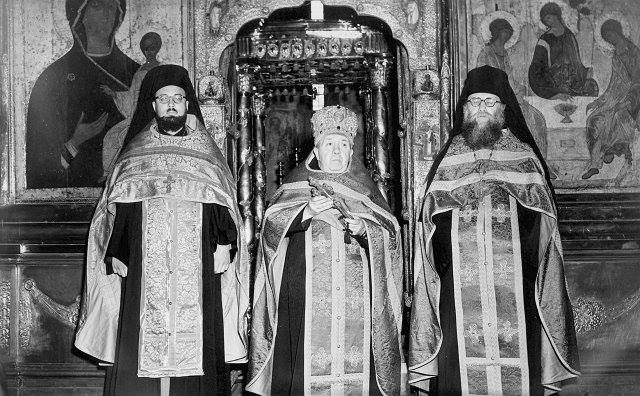 A celebration in the 1940's in the church of the Holy Trinity at the Trinity-St. Sergius Lavra with Hieromonk Denis (Chambault) of the Western Rite community in Paris
A celebration in the 1940's in the church of the Holy Trinity at the Trinity-St. Sergius Lavra with Hieromonk Denis (Chambault) of the Western Rite community in Paris
What does the Western Rite have that the Eastern Rite doesn’t?
This question, which also has been asked often, I have intentionally placed at the end of my discussion. This is a difficult question to answer due to the fact that it is usually framed in such a way so that however the person may answer, they can be accused of saying that Orthodoxy is lacking in some way.
I think, rather than thinking in terms of one liturgical expression lacking in something, that it would be better to point out the strength that the Western Liturgy brings to Orthodoxy. Simply put, this strength is one thing: the presence of silence.
The Byzantine Liturgies are beautiful, moving, majestic, and they draw us into the eternal now, there is no question about it. But when we examine the liturgy of the West, we find that the strength which it brings, besides being equally beautiful and majestic, is the role that silence plays in the Liturgy.
We cannot over-emphasize the role that silence (hesychia) plays in Orthodox spirituality, and we have saints who are hesychasts who devote their entire life to seeking and experiencing God in cultivation interior silence. What the Western Rite offers us is a change, during the Holy Liturgy, to focus on exterior and interior silence. Indeed, there are entire sections of the Mass that are celebrated in complete, or nearly complete silence.
For example, during the preparation of the Holy Gifts, which we in the East call Proskimedia, and which happens during the Liturgy in the West, is done in silence. Also, during the consecration of the Mystery, the only sound is the low voice of the priest, praying over the gifts before their elevation. This allows the people to silence themselves, and to focus on the coming of Christ in the Eucharist, bringing about the possibility for a preparation of the heart which is without distraction.
It would be a mistake to allow this focus, which is so central to our faith as Orthodox, to fade away, and worse yet, to ignore it.
Conclusions
We, as Orthodox, must examine ourselves deeply, and gauge whether our objection to the Western Rite, based on any of these arguments (or others), is based on actual fact, or on our own pride. This is a hard truth to consider, but we must consider it. If we are not willing to set aside our own pride and our own preferences for what we think is correct in this regard, then we will not even be able to flee from divisiveness in our relationships with other Eastern Rite Orthodox faithful. How sad this is. We must, as Christians, be better than this. We must examine anything that comes to us on its own merits, on its fidelity to the Apostolic Faith, and not hold our own opinion up as a measure against it.
At the end of the day, the Holy Church has granted the celebration of the Western Liturgies, and has proclaimed them Orthodox. These Liturgies have been celebrated by modern saints of God, who encouraged their use and growth. The Orthodox Western Liturgies encouraged all the Western saints of the first millennium, and fed the faithful with the Bread of Life. Thus, the weight of their merits is incalculable, because they hold, in truth, the experience of Christ of one thousand years, and beyond, into Eternity.
The many Eastern Rite Orthodox Christians who have a tendency to criticize, demean, or even openly persecute the Western Rite usage must re-examine their motives for doing so. If the Western Rite is examined anew and found lacking in Orthodoxy, then let it fall from use. However, if it be sound in doctrine, in practice, and be present in the acclamation and testimony of the saints, then let it not only stand, but also be encouraged, and given means to grow and flourish, that the West may once again stand beside the East in united proclamation of Holy Orthodoxy.
May it be so, for the sake of our Great God and Savior Jesus Christ, to Whom all glory and honor is due, with His Father Who is without beginning, and His All-Holy, Good, and Life-Creating Spirit, always, now and ever, and unto ages of ages. Amen.
02 / 03 / 2016
L’Icône Miraculeuse de Tchernobyl séjournera
au Monastère dit de la « Desiatina » à Kiev.

Malgré le haut niveau de radioactivité dans la « zone d’exclusion » à
Tchernobyl, cette icône resta non atteinte par les radiations.
Elle remonte à la première moitié du XIXème siècle et était à
l’origine de ce dicton local :
« Si saint Nicolas sort de l’église, la tempête commence ».
Aussi, on s’efforçait de ne pas la faire sortir de l’église de Tchernobyl.
LE MIRACLE
Après la révolution bolchévique, l’église fut transformée en entrepôt,
mais, lorsque l’église fut à nouveau ouverte au cours de la seconde
guerre mondiale, une famille qui avait caché l’icône, la rendit à
l’église. En 1986, lorsque se produisit la catastrophe nucléaire, la
ville fut désertée et tout le district évacué, mais l’icône resta dans
l’église, dédiée au prophète Élie.
Alors que des malfaiteurs erraient
dans la zone après qu’elle fût désertée par ses habitants, ils ne purent
piller l’église. Ils reconnurent alors que leurs forces les avaient
quittés soudainement. En 1990, dans « la zone d’exclusion », des
incendies de forêts se répandirent avec une puissance inhabituelle.
L’incendie s’approcha des habitations voisines. Les habitants
désespérés s’approchèrent du feu avec des icônes, dont celle de saint
Nicolas de Tchernobyl. Et tous ont été témoins d’un nouveau miracle
: aux yeux de tous, l’incendie changea soudainement sa trajectoire et
se dirigea vers le fleuve, puis s’éteignit rapidement. Actuellement,
l’icône se trouve dans l’église Saint-Élie à Tchernobyl. Des
processions avec l’icône ont eu lieu dans de nombreuses églises de
Kiev, dans les villes et les localités de la région, principalement celles
où se trouvent des victimes et des réfugiés de la catastrophe de
Tchernobyl. Nombreux sont ceux qui racontent la sensation d’une
chaleur étonnante et de grâce qui émanent de cette icône. Certains
ont remarqué que parfois, lors de la célébration d’offices
d’intercession, l’icône chauffe à ce point, qu’il est impossible de la
vénérer.
(Source: Michel B. Habib )
La méditation
Les plus généreux ne sont pas toujours ceux que l’on croit. Les plus souffrants non plus. C’est pourquoi la relation entre l’hospitalier et le malade n’est pas univoque, simple affaire de générosité chez l’un, de patience chez l’autre. Les rôles parfois se croisent : le malade attend de pouvoir donner, lui aussi. Et l’hospitalier de recevoir. Et tous deux, en attente d’autre chose de plus grand encore : d’une guérison, d’une réconciliation. Tous deux, vulnérables et pécheurs, en attente de Dieu. Leur commun pèlerinage les mène vers la maison de Dieu.
Dieu lui-même est en mouvement. Le prophète Osée a une formule foudroyante : il évoque un retournement du cœur de Dieu à la vue de la misère de son peuple. Retournement par lequel la colère est balayée au souffle de la miséricorde et au souvenir de l’Alliance donnée. « Vais-je t’abandonner, Éphraïm, et te livrer, Israël Non ! Mon cœur se retourne contre moi ; en même temps, mes entrailles frémissent. » On entend sourdre, des profondeurs, un amour plus fort que la colère, un amour qui engloutit la colère, malgré l’infidélité et la légèreté du peuple d’Israël. Que le pardon soit accordé ou reçu (dans le fond, il n’y a pas si grande différence, la difficulté est presque la même), il est toujours bouleversant, retournant. Tissé de joie et de douleur, car la joie est joie d’une victoire sur la douleur, d’un renversement de la douleur. « Il y aura de la joie dans le ciel pour un seul pécheur qui se convertit, plus que pour quatre-vingt-dix-neuf justes qui n’ont pas besoin de conversion. »* *Évangile selon saint Luc, chapitre 15, verset 7.(Source: Carême dans la Ville)
|
Programme des prochaines semaines au Monastère Syriaque de la Bienheureuse Vierge Marie, Mère de Miséricorde:
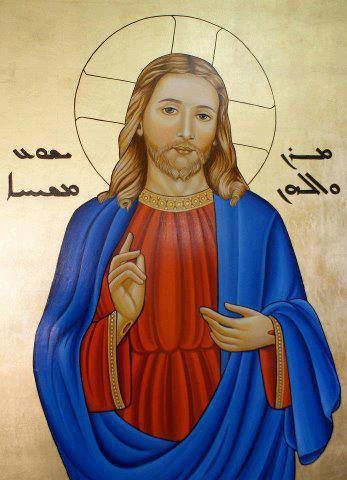
Program in the coming weeks
Syriac Monastery of the Blessed Virgin Mary, Mother of Mercy:

*Dimanche 6 Mars,
Pèlerinage mensuel à N-D de Miséricorde
Messe à 10h30,.Repas fraternel et réception des fidèles de 13h30 à 17h30.
* Sunday, March 6,
monthly pilgrimage to N-D Mercy
Mass at 10:30 .Repas brotherly reception and loyal 13:30 to 17:30.
*20 Mars :
RAMEAUX (Dimanche des Hosanna) Bénédiction solennelle des rameaux et Messe à 10h30,.Repas fraternel et réception des fidèles de 13h30 à 17h30.
* March 20:
PALM (Sunday Hosanna) Solemn Blessing of the Palms, Mass at 10:30 .Repas brotherly reception and loyal 13:30 to 17:30.
RETRAITE DE SEMAINE SAINTE des Rameaux au lundi de Pâques.
(Période popice pour les préparation au Baptêmes et receptions dans l'Eglise par Chrismation.)
RETRAITE DE SEMAINE SAINTE AU MONASTERE SYRIAQUE
Pour une guérison et une unification totale de l'homme en chemin vers le Père par le Christ Rédempteur notre Divin Médecin et dans la Grâce du St Esprit
INSCRIVEZ-VOUS !...
Inscrivez-vous pour suivre au plus près le Christ, divin Médecin de nos Esprits,de nos âmes et de nos corps pour vous laisser guérir par Lui !...
RETIREMENT OF HOLY WEEK Palm Sunday to Easter Monday.
SIGN UP! ...
Sign up to follow closely the Christ, Divine Physician of our spirits, our souls and our bodies to let you heal Him! ...
*25 Mars:
Vendredi Saint, 15 h Office Liturgique Syriaque de la Crucifixion...
* March 25:
Holy Friday, 15h Syriac Liturgical Service of the Crucifixion ...
*26 Mars :
Samedi Saint: 21h , Bénédiction du feu nouveau et Veillée pascale au rythme des Services Liturgiques Syriaques, Messe de la Résurection de Notre-Seigneur.
* March 26:
Holy Saturday: 21h, Blessing of the New Fire and Vigil at the whim of Liturgical Services Syriacs, Mass of the Resurrection of Our Lord.
*27 Mars :
PÂQUES, Messe à 10h30,.Repas fraternel et réception des fidèles de 13h30 à 17h30.
* March 27:
EASTER Mass at 10:30 .Repas brotherly reception and loyal 13:30 to 17:30.
*Lundi 28 Mars:
PELERINAGE A LA CROIX GLORIEUSE
Messe à 7h au Monastère, départ pour Lisieux.Prières à Lisieux en matinée et déjeuner sur place.
Procession et Prières à la Croix Glorieuse de Dozulé dans l'après-midi.
Retour au Monastère vers 19h.
* Monday, March 28:
PILGRIMAGE TO THE GLORIOUS CROSS
Mass at 7 am at the Monastery, departure for Lisieux.Prières to Lisieux in the morning and lunch.
Procession and Prayers to the Glorious Cross of Dozulé in the afternoon.
Back at the monastery around 19h.
*Pèlerinage à Argenteuil:ou
LA SAINTE TUNIQUE
SERA EXPOSEE
du 25 mars au 10 avril 2016
*Lundi 4 Avril, Pèlerinage des Chrétiens Syro-Orthodoxes de Saint Thomas,
SOYEZ TOUS PRESENTS,
INSCRIVEZ-VOUS DES MAINTENANT !
Inscriptions:
Monastère Syriaque de la Bse Vierge Marie, Mère de Miséricorde,
Brévilly
61300 CHANDAI.
Tel: 02.33.24.79.58
ou: 06.48.89.94.89 (Par sms en laissant vos coordonées)
Adresse courriels: asstradsyrfr@laposte.net
Note:
l'Eglise Syro-Orthodoxe- Francophone est une Eglise
Orthodoxe-Orientale.
Le Monastère Syriaque est un Centre de Prières pour l'unité
des Eglises Apostoliques, l'unanimité du Témoignage Chrétien
et la paix du monde.
Pour les services pastoraux rendus au Monastère comme l'accueil
des fidèles pour de courts séjours ou des retraites spirituelles ,
nous n'exigeons aucun fixe.
Les offrandes sont libres et non
obligatoires.
Toute offrande fait cependant l'objet d'une
déduction de votre revenu imposable à raison de 66°/° de votre
revenu). Libeller tous C B à l'ordre suivant " Métropolie E S O F "
Évangile de Jésus Christ selon saint Luc 11,14-23.
En ce temps-là, Jésus expulsait un démon qui rendait un homme muet. Lorsque le démon fut sorti, le muet se mit à parler, et les foules furent dans l’admiration.
Mais certains d’entre eux dirent : « C’est par Béelzéboul, le chef des démons, qu’il expulse les démons. »
D’autres, pour le mettre à l’épreuve, cherchaient à obtenir de lui un signe venant du ciel.
Jésus, connaissant leurs pensées, leur dit : « Tout royaume divisé contre lui-même devient désert, ses maisons s’écroulent les unes sur les autres.
Si Satan, lui aussi, est divisé contre lui-même, comment son royaume tiendra-t-il ? Vous dites en effet que c’est par Béelzéboul que j’expulse les démons.
Mais si c’est par Béelzéboul que moi, je les expulse, vos disciples, par qui les expulsent-ils ? Dès lors, ils seront eux-mêmes vos juges.
En revanche, si c’est par le doigt de Dieu que j’expulse les démons, c’est donc que le règne de Dieu est venu jusqu’à vous.
Quand l’homme fort, et bien armé, garde son palais, tout ce qui lui appartient est en sécurité.
Mais si un plus fort survient et triomphe de lui, il lui enlève son armement auquel il se fiait, et il distribue tout ce dont il l’a dépouillé.
Celui qui n’est pas avec moi est contre moi ; celui qui ne rassemble pas avec moi disperse. »
Par Origène
(v. 185-253), prêtre et théologien
Homélies sur Josué, 15,1-4 (trad. SC 71, p. 331,345)
Si les guerres [de l'Ancien Testament] n'étaient pas le symbole des guerres spirituelles, je pense que jamais les livres historiques des juifs n'auraient été transmis aux disciples du Christ qui est venu enseigner la paix.
Jamais ils n'auraient été transmis par les apôtres comme une lecture à faire dans les assemblées.
A quoi serviraient en effet de telles descriptions de guerres pour ceux qui s'entendent dire par Jésus :
« Je vous donne ma paix, je vous laisse ma paix » (Jn 14,27), pour ceux qui se voient ordonner par l'apôtre Paul :
« Ne vous vengez pas vous-mêmes »
(Rm 12,19)
et « Souffrez plutôt l'injustice, laissez vous plutôt dépouiller » (1Co 6,7).
Paul sait bien que nous n'avons plus à livrer de guerre matérielle, mais qu'il faut combattre à grand effort dans notre âme contre nos adversaires spirituels.
Comme un chef d'armée, il donne ce précepte aux soldats du Christ :
« Revêtez-vous des armes de Dieu, afin de pouvoir résister aux embûches du diable »
(Ep 6,11).
Et pour que nous puissions puiser dans les actes des anciens des modèles de guerres spirituelles, il a voulu qu'on nous lise dans l'assemblée le récit de leurs exploits.
Ainsi, si nous sommes spirituels, nous qui apprenons que « la loi est spirituelle » (Rm 7,14), nous rapprochons à cette lecture « des réalités spirituelles en termes spirituels »
(1Co 2,13).
Ainsi nous considérons à travers ces nations qui ont attaqué visiblement l'Israël matériel, quelle est la puissance de ces nations d'ennemis spirituels, de ces « esprits mauvais répandus dans les airs » (Ep 6,12), qui soulèvent des guerres contre l'Église du Seigneur, le nouvel Israël.









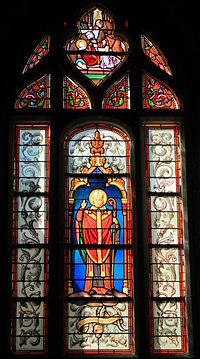
!["The Lord called His disciples blessed, for He said, 'Blessed are your eyes, for they see' (Lk.10:23). The apostles saw Christ in the flesh; they witnessed His sufferings and His miracles, and heard His words. We too desire to see, and to hear, and so be filled with gladness. They saw Him face to face, since He was physically present. Since He is no longer physically present, we hear His words read from books, and by hearing, our souls are sanctified and filled with blessings, and so we worship [God], honoring the books from which we hear His words. So also, through the painting of images, we are able to contemplate the likeness of His bodily form, His miracles, and His passion, and thus are sanctified, blessed and filled with joy. Reverently we honor and worship His bodily form, and by contemplating His bodily form, we form a notion, so far as possible for us, of the glory of His divinity. Since we are fashioned of both soul and body, and our souls are not naked spirits, but are covered, as it were with a fleshly veil, it is impossible for us to think without using physical images" - St. John of Damascus (On the Divine Images; SVS Press pg. 72)](http://img.over-blog-kiwi.com/1/49/89/80/20160303/ob_b4e7d5_10599138-825953614089735-8293001513559.jpg)
